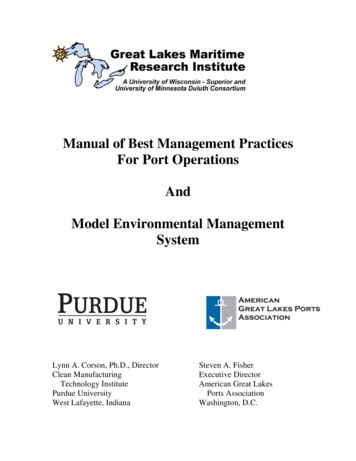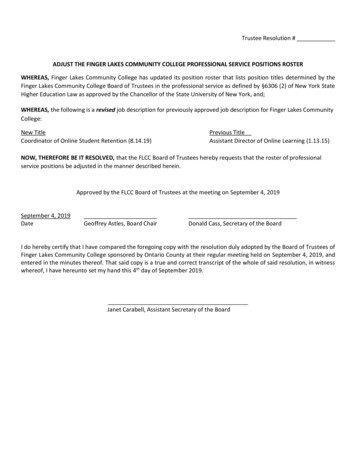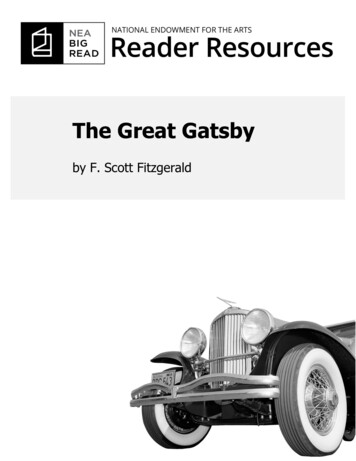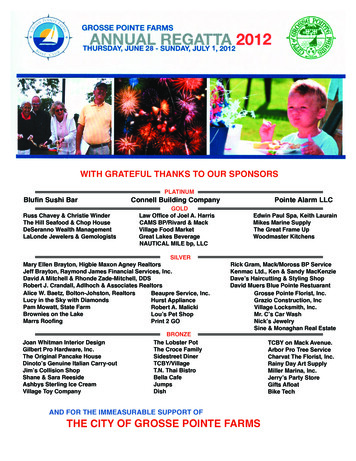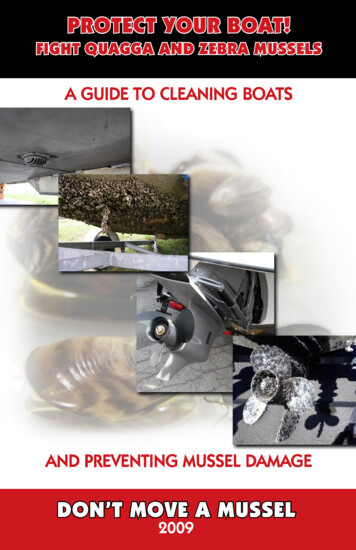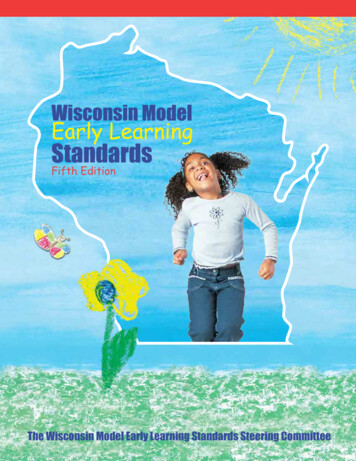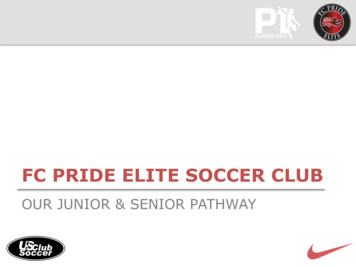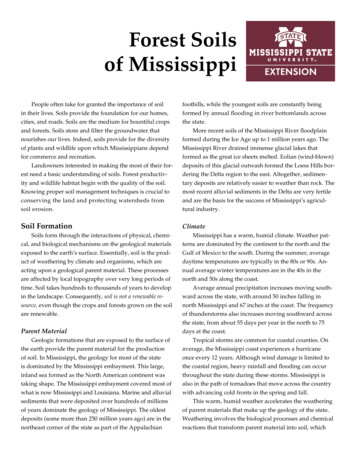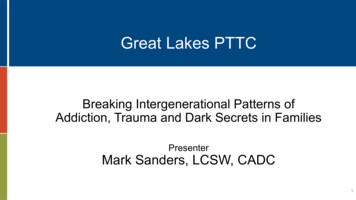
Transcription
Great Lakes PTTCBreaking Intergenerational Patterns ofAddiction, Trauma and Dark Secrets in FamiliesPresenterMark Sanders, LCSW, CADC1
Risk Factors for IntergenerationalPatterns of AddictionTraumaPhoto: johannhari.com
Healing As a nation, wehave never healedhistorical trauma,making it difficult forprevention efforts tobe effective.
Trauma: We are a nation of survivors Slavery Indentured servitude Native Americans Hispanics/Latinos Immigrants Refugees Wars
Lessons from History“Americans drank more alcoholper capita, the first 40 yearsafter the signing of theDeclaration of Independence,than anytime in our nation’shistory.”Photo: amazon.com
Rationale The British had all the tea Water was impure Milk spoiled easilySource: /boston-tea-party
Today
WashingtonCrossing theDelawareSource: Flickr Commons
Martha WashingtonLeader of the TemperanceMovementPhoto: Flickr Commons
Frederick DouglassLeader of the BlackTemperance movement“We can’t staggerto freedom.”Photo: iStock
The Bill of RightsThe first 10 Amendments of theConstitution reflect all thethings a trauma survivor wouldneed to fee safe. Amendment 1: Freedom ofSpeech Amendment 2: the Right toBear Arms
The Bill of Rights, continued. Amendment 3: You don’t haveto let soldiers live in yourhouse Amendment 4: Nobody cansearch your body or houseunless they can prove to ajudge there is good cause todo so
Amendment 5 A grand jury is needed for youto be tried for a serious crime The government can’t justtake your home withoutpaying a fair price
Amendment 6 You have the right to aspeedy trial
The Bill of Rights: 7: You have the right to a jurytrial 8: You have the right to areasonable bail
You Have Other Rights Amendment 9: You haveother rights, not just thoselisted in the Constitution Amendment 10: Anything thatthe Constitution does not saythat Congress can do, is leftup to the states and thepeople
George WashingtonSource: flickr commons
The Civil WarSource: flickr commons
Alcohol rationsDuring the Civil War soldierswere given a pint of alcohol perday to deal with the trauma ofwar. Source: William White, MA Photo: PBS
The National Residue of Our Unresolved HistoricalTrauma More guns than people The highest homicide rate in the world The highest imprisonment rate in the world Lead the world in cigarette smoking Lead the world in illicit drug use20
Trauma, ContinuedBecause we have never recovered fromour historical trauma,we have a high tolerance for traumawithout taking action.21
FentanylMuch of the fentanyl coming into theUnited States comes from China, throughthe mail and legal points of entry.Photo: https://www.dea.gov/galleries/drug-images/fentanyl
Al CaponeSource: flickr commons
The 1930sDuring the War on Drugs on the 1930s, the biggest drug dealerswere not gangs—they were government agents who took bribes.Chasing the Scream
Prevention EffortsTo begin breaking intergenerational patterns of addiction,prevention efforts need to focus on decreasing the demand fordrugs.25
Ending the CycleInherited familytrauma
Tuskegee ExperimentSource: flickr commons
Dr. Yvette Pye
Transcending Geography29
Family Pride
Adverse Childhood Experiences (ACEs)
ACEs:Before age 18 (10 ACEs) Abuse (physical, emotional, sexual and/or neglect) Exposure to parental domestic violence Parental mental illness or Substance Use Disorder Parental separation or divorce Loss of a parent through death, deportation, incarceration
Results Compared to an ACEs Score of 0, a person with a score of 4 is8 times more likely to develop a substance use disorder A score of 5, the person is 10 times more likely to develop asubstance use disorder Life expectancy of a person who scores 6 is age 60 (monitoring)33
ACEs Results Each ACE increases opioid relapse rates by 17% Each visit to a trauma-informed program reduces relapses by 2%Dr. Karen Derefinko, University of Tennessee
Strategies to Break IntergenerationalTransmission of Addiction1. Shift the unit of service in prevention and treatmentfrom the individual to the family and extended family.
Lessons from IcelandTransition from the highestunderage drinking in Europe tothe lowestPhoto: iStock
Parent Patrols Parents signed pledge Monitor kidswhereabouts Make sure the kidshonor curfew Lots of activities for thekidsPhoto: 4dcb3752c37
Miracle Village, Gary, Indiana Services in public housing for women andchildren Four adjacent Row Houses: Addiction,Mental Health, Medical, Children’sProgramming Recovery Coaching38
Alkali Lake Tribal Band British Columbia, The Honour of All From 100% alcoholism to 95% recovery One recovery at a time Alcoholics Anonymous Treatment House repair while in treatment Community development39
Alkali Lake Tribal Band: Honoring Tradition Return to tribal religion and cultural practicesReinstitution of the chief and tribal councilAddress historical traumaRe-define addiction as a response to oppression and traumaImprovement of schoolsPrevention and treatment simultaneouslyPersonal growth seminars Spreading the approach to other indigenous communities40
Clinical Strategy 2 Let parents with substance use disorders knowthat their children are at increased risks fordeveloping SUD Provide education on how parenting styles canimpact child and adolescent substance use.
Three Parenting Styles Autocratic: children haveno voice Democratic: childrenhave a voice Laissez – faire:anything goes42
Four Important Questions for Clients How can we help you maintain your recovery? What will your spouse/partner do to take care of self? What do your children most need to enhance their present andfuture wellbeing? How can we help you deal with the trauma of early familyrecovery?43
Clinical Strategy 3Integrate services for couples, children and familieswithin all prevention, addiction treatment programs.
Clinical Strategy 4When working with adolescents at risk for addictions,provide preventive services for their younger siblings.
Clinical Strategy 5Help families with generational histories ofaddiction think about new family memories.
New Family Memories“Son, we shouldn’t becomparing arreststories. We need newmemories.”
“Let’s Play A.A.”48
Clinical Strategy 6Help families with generational addiction improve parent/child relationships. Parenting time with each childFamily rituals and drug free celebrationsDrug free cultural celebrationsPositive relationship with an aunt or uncleCommunicate high expectation and support their dreamsMentorship for each child
Clinical Strategy 7Teach healthy family boundaries Loose: everyone is doing their own thing, no one isaware of what’s going on with other family members Enmeshed: family members are too close Healthy: everyone is allowed the 5 freedoms
The Five FreedomsTo think what you think rather than what youshould thinkTo feel what you feel rather than what youshould feelTo want what you want rather than what youshould wantTo see what you see rather than what youshould seeTo imagine your own self-actualization
Clinical Strategy 8Address family secrets
Good Family Secrets Santa Claus The tooth fairy Surprise birthday party How you feel about peopleas people
Dark Secrets
Level I Dark SecretsPhobiasThe intimate details of an affair
Level II Dark SecretsYour real ethnicityAdoption statusWho your parents really are
Jack Nicholson Source: Flickr
Secrets TheoryEveryone in the family knows the secret. They will repeatthe secret across generations until the secret is openlydealt with.Source: Family Secrets
Level III Dark SecretsAddictionsLiving with addictions
Level IV Dark SecretsThese secrets cause the most damage if not discussed Incest Childhood sexual abuse Sexual assault Torture Witnessing extreme violence “The secret that you only tell once”
Protective FactorsTo Prevent the Intergenerational Transmission ofAddiction
Starting Point Source: Flickr Commons
Family Dinners
Lessons from mothersMother Nurture: Life Lessonsfrom America’s Bestand BrightestStephanie Hirsch withHannah SeligsonPhoto source: Amazon
Steven SpielbergSource: Flickr
Protective Factors:Children andadolescents whoeat dinner withparents 5times/week ,use 3 times fewdrugs than thosewho eat dinnerwith parents 2times/week
More Protective Factors Family celebrations Mentorship A membership Later onset of substance use Early treatment of mental illness and trauma67
Protective Factors For Childrenof Parents with SUDs A Matrix (a safe place) Constant & predictable routines The ability to get adopted by surrogate families The behavior to see the consequences of behavior before they engage init. Lots of activities
More Protective Factors for COAs Address Fetal Alcohol Spectrum A belief that they are responsible for managing their own lives A sense of belonging Later onset of substance use Early trauma and attachment-based therapy Insight69
Cause, control, cure:My parent has a disease that is characterized by emotionalunavailability, broken promises, and inconsistency.I did not cause this problem.I cannot control it or cure it.
Protective Factors COAs: An affirming mirror An adult who has high expectations Later onset of substance use Encourage merit of excellence rather than perfection The chance to express their feelings71
Appropriate Response to the Feelings“I believe you.”Normalization of the feelingsReflection of feeling “I could see how you would feel that way.” “You are not alone.”72
Drew BarrymoreSource: flickr commons
Charlize Theron When Charlize was 15, her motherwent to prison for killing her dadwho often physically abused hermom when he was under theinfluence.Photo: Flickr Commons
Kelly OsbourneSource: flickr commons
Halle BerryHer father had alcohol usedisorder and physically abusedher mother and sister.
Tupac ShakurTupac Shakur’s mother wasaddicted to crack cocaine.Source: flickr commons
Eminem
Jay ZSource: flickr commons79
Nikki Minaj Her father was addicted toalcohol and other drugs.Photo: Shutterstock
Rihanna Source: Flickr
President Barack Obama
President Bill ClintonSource: flickr commons
President Ronald ReaganSource: flickr commons
Don Coyhis, Founder, White BisonThe Healing Forest:The Entire Community as theRecovery Center
The Healing Forest“Suppose you have 100 acres full of sick trees who want to getwell. If each sick tree leaves the forest to find wellness and thenreturns to the forest, they get sick again from the infection of therest of the trees. The Elders taught us that to treat the sick trees,you must treat the whole forest. You must create a healing forest.If not, the trees will just keep getting sick again. The communityforest is now filled with alcoholic trees, drug-addicted trees, codependency trees, domestic violence trees, and trees withmental illness. The soil in which those trees are growing ismissing the ceremonies, the songs, the stories, the language andthe wisdom of our Elders.”
Hidden resources?What hidden resources existwithin the communitythat can be a part of a healingforest to support recovery andhelp break intergenerationalpatterns?
The Healing Forest:The Community as the Treatment Center FamiliesTreatment centersFaith based organizationsOther social service organizationsPersons in long term recoveryThe formerly incarceratedEmployers-we can learn a lot from PortugalConcerned citizensTrauma specialist (current and historical)88
Examples of Healing Forests
Scott County Indiana:Where it’s Cool to be in Recovery!90
Scott County Story:In 2015: Jobs went away 200 reported cases of HIV diagnosis in a country of 4000people connected to an increase in injection drug use in thecounty This made headlines worldwide Multiple challenges in the rural county: poverty, highunemployment, limited access to medical care, a shortage ofaddiction treatment facilities91
Creating a Healing Forest in Scott County Tom Cox, a lifelong Indiana resident formed a RecoveryOriented System of Care (ROSC). He mobilized theentire community. The goal of the Scott County ROSC is to see that all ofScott County embraces a culture of recovery through acoordinated network of community- based services andsupports92
Results in Scott County Recovery support groups in the county increased from 30 peopleattending 1 recovery support group per week to 330 people attending18 weekly meetings at 9 locations. An increase in 1000% of individualsmaking long term recovery efforts 37 Recovery Coaches trained and hired to help support recoverythroughout the county including hospital emergency rooms The syringe service program referred 75% of the participants to drugtreatment New cases of HIV reduced from 154 in 2015 to 8 in 201793
Illinois ROSC Councils RFP sent to providers 11 providers selected Partnership with Great Lakes ATTC to provide technicalassistance94
IL ROSC A statewidenetwork95
Illinois ROSC Councils: The 11 lead agencies recruited key stakeholders of thecommunity to join the council Use of social mediaMonthly meetingsEducating the council about ROSCEducation about stigmatization and de-stigmatizinglanguageCreation of a name, mission and vision statement together asa council along with a five-year strategic plan96
Illinois ROSC Councils, Continued Each council consisted of 30 to 150 membersOne lead agency helped develop ROSC councils in each of the6 counties servedOne council opened a Recovery Drop In-centerStigma reduction, education and community mobilizationEach council recruited people with lived experience to beinvolvedLead agencies started partnering with each otherExpansion of peer-based mutual aid options97
The Role of Employers in theHealing Forest Portugal Vocational schools Community colleges98
Trainer’s Contact InformationMark Sanders, LCSW, CADCGreat Lakes ATTC, MHTTC, andPTTCState Program Manager-Illinoismasanders5@wisc.eduWebinar recording and presentation slides will be available on theGreat Lakes PTTC website soon!www.pttcnetwork.org/greatlakes
Chasing the Scream. Prevention Efforts. To begin breaking intergenerational patterns of addiction, prevention efforts need to focus on decreasing the demand for drugs. 25. Ending the Cycle. Inherited family trauma. Tuskegee Experiment. Source: fl
